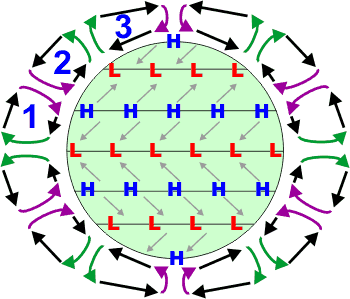
Northern hemisphere long-term mean sea level pressure,
Southern hemisphere long-term mean sea level pressure,
2. A lake 15 km long is initally at rest with no wind blowing on it. One day, a steady wind starts to blow along the axis of the lake at a rate of u_10 = 10 m/s. Calculate the wind stress. After several days, the lake comes into equilibrium with the wind stress. In steady state the wind stress is balanced by the hydrostatic pressure force of the elevated water at the downwind shoreline. What is the final difference in height of the water between the upwind and downwind ends of the lake? (Density of air = 1.3 kg/m3; Drag Coefficient from Stewart Fig. 4.6)
2. What direction is the prevailing wind at the equator?
3. If the wind speed at 10 meters height is 10 m/sec, what is the wind stress on the ocean? (use drag coefficients from lecture or from Stewart electronic notes)
4. Is the Walker circulation in approximate geostrophic balance? Is the jet stream in approximate geostrophic balance?
5.On the weather map of the U.S. used in the previous lecture (lecture 4), identify the high pressure regions and note for yourself which the geostrophic wind should go around the high.
6. The North Atlantic atmospheric pressure is dominated by two large features - the Bermuda High and the Iceland Low. At about what latitude is the center of each of these? Same question for the high pressure center and the Aleutian Low in the North Pacific.
UCAR MetEd unit on climatology (lots about weather at the beginning, moving to larger scale) (Nice illustrated introduction, also includes ocean currents; for the interactive version, leave out the print.htm in the url.)
Munn, T., Encyclopedia of Global Environmental Change (32 various pages):
These articles are included in the scanned pdf:
Excellent basic textbook for further reading: Wallace, J.M and P. V. Hobbs, 2006. Atmospheric Science: an Introductory Survey, Second Edition. Elsevier.
NASA website for Winds http://winds.jpl.nasa.gov/
Quikscat wind images http://airsea-www.jpl.nasa.gov/seaflux/quikscat/quikscat.html
NASA JPL site for air-sea interaction and wind data http://airsea-www.jpl.nasa.gov